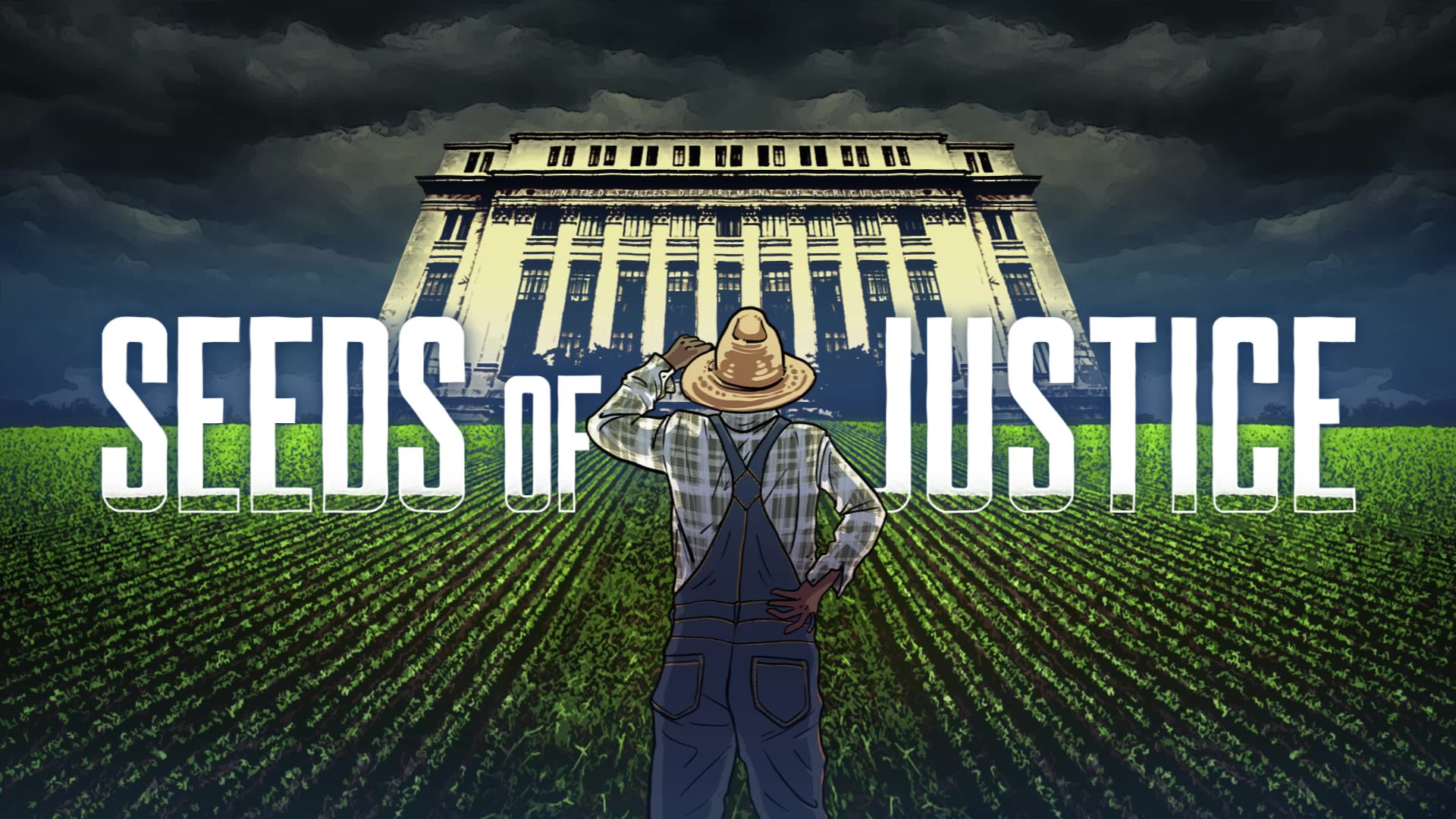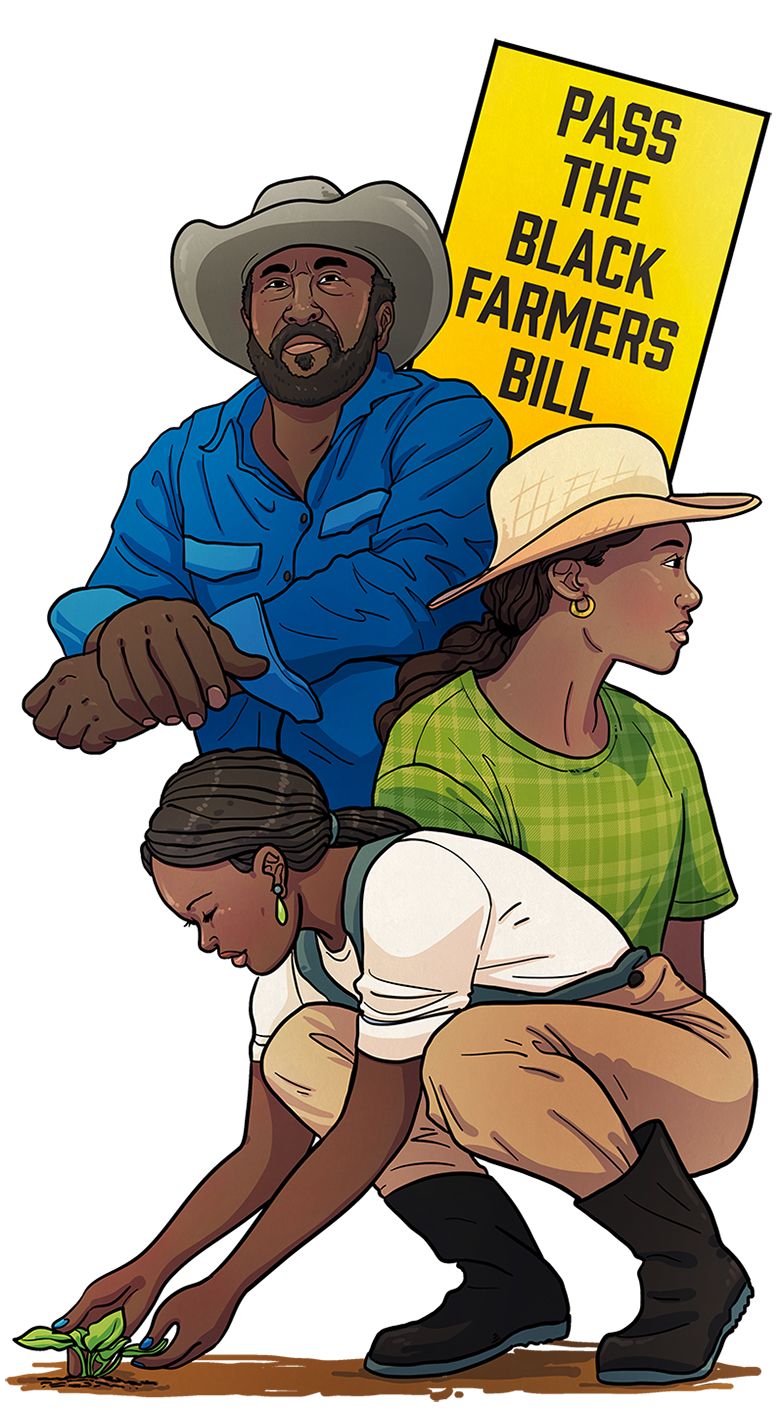

“The Mississippi Delta begins in the lobby of the Peabody Hotel and ends on Catfish Row in Vicksburg.”
David Cohn wrote that in “God Shakes Creation” in 1935 and many people still hold it to be true today.
It’s the same Delta region, extending into Arkansas, Mississippi, Tennessee and Louisiana, that has forever been hailed as one of the most agriculturally rich and fertile regions in the world. With the region’s rich, black, fertile alluvial soil stretching from horizon to horizon, combined with the temperate climate and extended growing seasons, there is no question it still holds true today.
And African Americans have been central to the modern success and agricultural bounty of the Delta itself.
Ever since their forced arrival in America, Black people have tilled the soil of the Delta. For generations they have farmed the countryside, planted countless crops, cultivated the land and been central to the agricultural economy the nation has relied upon for years. Their labor was essential in creating the industry; and it transformed how the country produced crops and participated in the capitalist global economy.
But the ability of the Black farming community to accumulate land, wealth, generational businesses and income based on that history of agricultural prowess was blocked at most every turn, sometimes by violence but more often by the systems in power and discriminatory policies. These farmers have historically been denied equal access to bank loans; lending and capital, while also seeing federal policies like the Federal Homestead Act either exclude them entirely or offer them only the worst parcels of the worst land.
Even against this backdrop of long odds and industry discrimination, Black farmers in the South still managed to forge ahead as farmers throughout the region. But for years after the Civil War, when the infamous “40 acres and a mule” promise was made to some former slaves for their forced unpaid labor during slavery, the Black farming community was forced into more poverty and debt through sharecropping and with threats of economic intimidation that kept them living in perpetual debt for generations.
The Federal-level response to this systemic racial discrimination has been less than stellar. Over the years the country has seen many federal policies and programs fail to include Black farmers. Perhaps most disheartening is the U.S. Department of Agriculture’s history of discrimination, even after the passage of the monumental Civil Rights Act in the 1960s, as it continued to carry out patterns of discrimination against Black farmers, impacting countless families, farms and communities throughout the region around Memphis and throughout the South.
This is all part of the ongoing history of distrust, broken promises and discrimination between Black farmers and the USDA across multiple generations.
Even with historic class action civil rights settlements on their side, Black farming communities still have to fight for control of their land, equal debt relief and the respect of the agricultural industry and the USDA.
Recent work from the administration of President Biden has attempted to bring some amount of justice to this cause, but many of the same old problems are cropping up once again.
So, what is the root cause of this poor crop of equality and fairness harvested by Black farmers?

HOW DID WE GET HERE?
FROM 40 ACRES TO CLASS ACTION
An interested party need only look at the famous failed promise of “40 acres and a mule” to see one of the country’s first examples of tragically doomed attempts to help Black farmers elevate their station in life in a fair way. The promise from the federal government has permeated most people’s cursory level cultural knowledge, but many individuals fail to realize that this potentially life-altering decree not only ultimately failed but did so because of the federal government itself.
In short, Union General William Tecumseh Sherman issued a wartime order to allot plots of land no larger than 40 acres to some freed slaves and their families after the land was seized from Confederate plantation owners. The order was revolutionary not only in the scope of potential impact for freed slaves and their families’ futures, but also with its origins in conversations General Sherman had with Black leaders in Savannah and other abolitionists.
Unfortunately, following the assassination of President Lincoln on April 15, 1865, President Andrew Johnson, a noted segregationist, rescinded the order, leaving Black farmers and freed slaves once again adrift.
It was only the first example of the federal government breaking its promise to Black farmers in America.
It also led to the massive growth of the sharecropping industry in the South, a system not much better than slavery in many ways, given the small wages and exploitation that existed alongside it.
But Black farmers persisted, though their numbers kept declining and inequity persisted.
At the start of the 20th century, one in seven farmers in the United States was Black. They owned more than 16 million acres of land in 1910. Fast forward to today and Black farmers have less than 4.7 million acres in total.
Between 1920 and 1999, 98.1% percent of Black farmers left their profession and 85% of the land owned by Black farmers was lost.
Much of this dramatic decline was due to overt discrimination from the USDA towards Black farmers.
For many years, Black farmers had complained publicly that they were not receiving equal and fair treatment when applying for farm loans or financial assistance. They alleged that they were being denied USDA loans or being forced to wait longer for loan approval than non-minority farmers, leaving many Black farmers facing foreclosure and financial ruin because of these delays from the USDA. Additionally, many Black farmers claimed that the USDA was in no way whatsoever responsive to their discrimination complaints, with a massive backlog of unresolved complaints piling up after the USDA’s Civil Rights Office was closed in 1983.
That backlog was part of the reason that the USDA commissioned a consulting firm in 1994 to analyze the treatment of minorities and women in Farm Service Agency programs and payments, looking at conditions from 1990-95 and primarily at disaster payment programs and Commodity Credit Corporation (CCC) loans.
The report ultimately found that minority participation in the programs was very low, and minorities received much less than their fair share of USDA money for disaster relief, crop payments and loans. Significant bureaucracy, a lack of information and years of distrust and discrimination all led to incredibly low rates of program involvement by minorities. The findings showed that the largest USDA loans (the top 1%) all went to corporations (65%) and white male farmers (25%). It also showed that loans to Black males were 25% less than those given to white males and 97% of disaster payments went to white farmers, with less than 1% going to Black farmers.
All of this resulted in then Secretary of Agriculture Dan Glickman ordering a suspension of government farm foreclosures across the country pending the outcome of an investigation into racial discrimination in the USDA’s loan program. That investigation’s findings ultimately recommended 92 changes to address racial bias at the USDA and put forth a Civil Rights Action Plan for the agency. But that plan did not satisfy the many Black farmers seeking redress of past wrongs and compensations for the losses they suffered as a result of the USDA’s discriminatory history and actions.

Pigford & Class Action Part 1
As a result, a proposed class action lawsuit, Pigford v. Glickman, was filed in 1997 by Timothy Pigford in the U.S. District Court for the District of Columbia on behalf of Black farmers against the USDA. It alleged that the federal agency had discriminated against Black farmers from 1983 to 1997 when they applied for federal financial help and again by failing to investigate allegations of discrimination, ultimately resulting in systemic discrimination against black farmers on the basis of race, in violation of the Fifth Amendment, the Equal Credit Opportunity Act, Title VI of the Civil Rights Act and the Administrative Procedure Act.
After two years of litigation, the case was settled by the parties in 1999 and would ultimately become the largest civil rights class action settlement in the history of the United States up to that point, with a total of more than $1 billion in cash relief, tax payments and debt relief. The decree ultimately allowed claimants to receive a $50,000 settlement plus loan forgiveness relief and offsets of tax liability. Today, the case is only surpassed by Keepseagle v. Vilsack, a case which Native American farmers brought against the USDA in the wake of the Pigford settlement.
It looked like a huge victory for Black farmers. But as has so often been the case throughout this group's history, it did not play out that way and Black farmers were left with even more mistrust for the Federal government as a result.
The terms of the Pigford settlement agreement were outlined in a Consent Decree by U.S. District Court Judge Paul Friedman in April of 1999. That decree stated that eligible farmers were required to file their claims by October 12 that same year and also said that those claimants that demonstrated the required “extraordinary circumstances” for missing that deadline could file at a later date of September 15, 2000.
Approximately 22,000 farmers filed claims before the initial deadline and slightly more than 60,000 additional individuals requested permission to file late under the extraordinary circumstances provision. Ultimately, only 16,000 claims were approved for monetary payments, but 7,000 individuals were flat out denied and fewer than 3,000 of the original 61,000 late filers were found to have demonstrated the extraordinary circumstances needed to file their claim late.
This meant that more than 58,000 farmers did not even have their discrimination claims heard at all. And only about 400 Black farmers received any debt relief as a result of this settlement.
That did not feel like a win for many farmers looking for help after decades of discrimination.
In general, there was a consensus that the relief process itself was also discriminatory and burdensome to the very Black farmers it was seeking to help. For instance, one requirement in the settlement stated that Black farmers had to find a “similarly situated” white farmer who had not been discriminated against, in order to receive their compensation. The restrictive deadlines and lack of access to needed USDA documents to fulfill these requirements further served to leave many Black farmers feeling even further disenfranchised and helpless.
Many claimants said the problem was at the local level. The Farm Service Agency (FSA), the USDA’s lending branch, had county offices throughout the country that were often the first and only point of contact for farmers seeking access to government assistance programs. Black farmers stated that their dealings with FSA officials (who are pivotal in determining if loans are granted) were often tinged with racial bias, inexperienced personnel and lack of resources to help applicants.
“The process put in place keeps you from being able to apply,” said Carolyn Jones, a Black farmer and executive director for the Mississippi Minority Farmers Alliance, in an interview with Politico. She cited issues such as overly complex applications, lack of access to a competitive market and outright discrimination.
The confusion and widespread concern facing the implementation of the settlement only increased in subsequent years. It became such an obvious issue that in 2008, due to concerns about the large number of applicants who did not obtain a determination on the merits of their claims under the original Pigford settlement, Congress included a new provision in the 2008 Farm Bill that permitted any claimant who had submitted a late request under Pigford and who had not obtained a determination on the merits of their claim to petition in federal court to obtain such a determination.
Pigford II
That 2008 Farm Bill did not totally re-open the original Pigford case. Rather, it allowed Congress to provide a new right to sue. However, even though it created a new cause of action for tens of thousands of Black farmers, the total amount of funding in that Farm Bill for new and valid claims was only $100 million.
Regardless of limited reimbursement funds, the Farm Bill resulted in numerous new and separate lawsuits being filed, with these claims being consolidated into a single new case, In re Black Farmers Discrimination Litigation (commonly referred to as Pigford II).
After nearly two years of ongoing litigation and recognizing that $100 million would never be enough to pay all the valid claims from Pigford II, a settlement agreement was reached between the USDA and Black farmers in the lawsuit, which required Congress to fund an additional $1.25 billion for successful claimants.
Just like the original Pigford settlement, Pigford II provided two avenues for relief: any Black farmer able to demonstrate suffering from racial discrimination and timely filing received up to $50,000 and debt relief; or a separate but longer claims process was also available to farmers which provided up to $250,000. Nearly every single claimant pursued the first avenue, and the claims administer at the time estimated that 50-60% of those claims were approved, in a surprise contrast to almost 70% of approved claims in the original Pigford settlement.
That may sound like Black farmers were finally recompensed and supported after so many years fighting for equality with the USDA. But even after close to $2.3 billion was approved in the two Pigford cases, fewer than half of the total claims filed by Black farmers were approved overall. That left an incredible number of Black families and farms out in the cold and even the ones who finally received their settlement money were still not on an even playing field with white farmers.
Even Judge Friedman himself, in his original Pigford ruling, acknowledged as much. The U.S. District Court judge stated that based on USDA county offices long history of discrimination against black farmers, “it is probable that no amount of money can fully compensate class members for past acts of discrimination,” and that “$50,000 is not full compensation in most cases.”
So, where does $2 billion in assistance and settlements put things almost a decade later?
A HISTORY OF PROMISES
MADE AND BROKEN
Despite the years of media attention, policy changes, litigation, historic class action settlements and ongoing political support, by 2021 during the still ongoing COVID-19 pandemic, farmers of color had lost 90% of their land compared to a century ago, due in large part to systemic racism and an endless cycle of debt.
Despite the federal government’s recent track record of broken promises of financial assistance and debt relief for Black farmers, many still saw hope with the Pigford settlements and the 2003 opening of the USDA Office of the Assistant Secretary for Civil Rights as important steps in the right direction. However, the Trump administration decided to leave the post unfilled throughout his term in office and soon after that a trade war with China resulted in farmers across the country experiencing record-breaking losses.
President Trump’s administration quickly came to the aid of the agricultural industry in response to this trade war, creating a subsidy program to mitigate farmers’ losses, which resulted in a record $46 billion farm aid program.
But once again, Black farmers said that the financial assistance passed them over.
John Boyd of Baskerville, Va., founder and president of the National Black Farmers Association (NBFA) and participant in the original Pigford case, said, "That money went predominantly to white farmers and large corporate farmers." In 2019, The Counter, a nonprofit news organization focused on food and agriculture, reported that 99 percent of the subsidies provided to farmers linked to the trade war with China went to white farmers.
And then, on the heels of the trade war, COVID happened. And, as with everyone else in America, it hit Black and minority farmers hard.
President Biden campaigned on addressing the history of systemic racism faced by Black farmers and healing the USDA’s strained relationship between the federal agency and the minority farming community. Biden spent the summer leading up to the election criticizing discrimination in agriculture, organizing roundtable discussions and tapping former Black government officials in a strong effort to attract the vote of Black farmers. His campaign even released a comprehensive plan to work with nonwhite farmers to tackle these issues.
So, when COVID shut the country down and hit the Black farming and agricultural communities a critical blow, it was no surprise to see President Biden include substantial relief for them in some of the largest COVID relief aid packages.
In March of 2021, the President signed off on The American Rescue Plan, also called the COVID-19 Stimulus Package, a $1.9 trillion economic stimulus bill, which included $4 billion in debt relief and $1 billion in technical assistance for Black, Latino and Native American farmers.
It was a massive win and relief for farmers of color in a time of crisis and it seemed to finally be a fulfilled promise of help for the Black farming community.
“We saw an opportunity with this COVID package to begin the process of righting so many wrongs,” Agriculture Secretary Tom Vilsack said at the time in a meeting with farmers of color.
The aid is necessary, Vilsack said, because today’s minority farmers have inherited the disadvantages of their forebears being denied access to USDA services.
“They simply weren’t able to expand their operations, to get the technology and the opportunities to grow their operations,” he said.
And so, thousands of Black farmers once again had reason to hope.
It was with that same sense of hope that Barbara Norman, a Black fourth-generation farmer, first opened a letter from the USDA in late 2021. That letter forgave more than half a million dollars she owed the department for various loans she’d taken out for her farm over the years.
“I was so relieved … it was amazing,” she said in an interview with NPR at the time, recalling her initial reaction upon opening the letter.
But a year after that interview, the debt was still a part of Norman’s life and was yet to be discharged.
That was because, yet again, hope was snatched from the hands of Black farmers by political forces beyond their control.
The American Rescue Plan program was swiftly blocked by a dozen lawsuits, including one led by former President Trump’s adviser Stephen Miller and current Texas Agricultural Commissioner Sid Miller, who argued that the program was discriminating against them for being white.
In what was seen as an unusual move at the time, the Justice Department let the deadline to appeal the injunctions that froze the debt relief program lapse, choosing to instead continue the court battle in local jurisdictions.
“The government vigorously defended this program in the courts but because of these injunctions, the $5 billion provided by the American Rescue Plan remained frozen,” said USDA press secretary Marissa Perry at the time. “This litigation would likely have not been resolved for years.”
Which meant that the only timely remedy was in the hands of Congress, who could repeal or amend any program that it had authorized.
Lawmakers took the “repeal” route with the program and then passed a second one through the Inflation Reduction Act (IRA).
Seemingly in response to the dozen related lawsuits involving the American Rescue Plan, lawmakers inserted a provision into the Inflation Reduction Act that repealed and replaced the original program with $3.1 billion in debt relief for “economically distressed borrowers,” which included white borrowers. They also included $2.2 billion for farmers who have faced discrimination, regardless of race, an item of particular note given the related lawsuits from white farmers saying that the original program discriminated against them.
For many farmers, that meant complete cancellation of their debt. For many others, it meant partial assistance or none at all, even after they were promised a clean slate and full debt cancellation just a year prior.
“They just basically came up with new programs that benefit white people, but they used Black farmers to get the white farmers assistance as well, and we help them get it,” said Eddie Lewis, a Black farmer from Louisiana in a recent interview with NPR’s political correspondent. “And we are still stuck without the help.”
According to representatives from the Federation of Southern Cooperatives, which advocates for Black farmers, the loss of trust is what makes even the possibility of help something that seems out of reach now.
“You lose a lot of trust when there was very little trust even in the beginning,” said Brandon Smith, the outreach coordinator for the Federation. “These farmers were promised something by the government and then put on hold for over a year and a half.”
“They were told money was allocated to them during the pandemic. They were not able to use those funds. Now the Inflation Reduction Act was passed, they added more money to that pool, but they aren’t doing debt forgiveness.”
Boyd feels the same way.
“Well, it’s been rough waiting for the relief,” said Boyd, who stated that he’s not happy with the new program, which no longer sets aside relief money specifically for farmers of color.
“The language isn’t good for Black farmers. It’s too wide of a definition,” he said. Now, any farmer who claims to have faced any kind of discrimination or financial distress can apply for one pot of aid.
“Distressed could be any farmer, age discrimination, white women who feel they’ve been discriminated against and even white male farmers,” said Boyd.
That leaves less for farmers of color who’ve borne the brunt of the federal government’s lending discrimination.
As of the first quarter of 2023, around $850 million had been paid out by the USDA as part of the Inflation Reduction Act to farmers who were either delinquent or on the edge of being foreclosed upon.
But even the USDA acknowledges that is only the beginning of the bureaucratic process.
"The steps we've taken so far are really for lack of a better analogy, to stop the bleeding," said Zach Ducheneaux, a member of the Cheyenne River Sioux Tribe and first Native American in the role of administrator of the Farm Service Agency in a recent interview.
He said the next step is to deal with 15,600 "complex cases," including borrowers on the brink of foreclosure and those near delinquency.
"This work requires diligence and time to make sure we are doing right by producers and fundamentally changing our approach to be better and in a long-lasting way," said Dewayne Goldmon, senior advisor for racial equity to the secretary of agriculture. "I'm in this job to advance racial justice and opportunity — and we will keep mending and improving our approach at USDA to ensure Black farmers and any other farmers who have been left behind in the past are no longer left behind."
Many Black and minority farmers have taken the attitude of “this is better than nothing,” when it comes to the IRA. but even if some farmers have received more aid than in previous years, the history of broken promises and discrimination will be hard issues to overcome.


WHAT COMES NEXT AND
WILL IT BE ANY DIFFERENT?
The Black farming community has seen too many instances of promises going unfulfilled and “help” coming with strings attached for them to hold out much hope that the current situation will ultimately play out in their favor.
It is already starting to look like many of the same issues that have plagued this matter in the past are rearing their heads again.
Lawsuits, politics and distrust are all back in play.
But so far, the USDA has shown initial progress on its plans for debt relief.
In the fall of 2022, the federal agency announced that it had already distributed approximately $800 million and allocated $500 million of that $3.1 billion pot of IRA debt relief money to tens of thousands of “distressed borrowers.” More recently, at the beginning of March 2023, the USDA announced another $43 million in payments had been made to almost 5,000 borrowers, but because the law itself did not require or authorize the USDA to track race, it is unfortunately unclear just how much of that money went to Black farmers specifically.
While it was distributing the debt relief money, the USDA also began the process of allocating that $2.2 billion fund for farmers who experienced USDA discrimination. As of this writing, USDA officials were reported as currently setting up partnerships with outside vendors and organizations that will process applications and distribute the funds through four regional hubs, with a goal of payments being made by the end of 2023.
When federal officials were asked whether this fund will track how much of the money ends up going to Black farmers in particular, a USDA spokesperson replied that the “USDA is still in the design phases” of its plan.
Perhaps it is not unexpected then that new lawsuits and policy initiatives have emerged in recent months.
Another Lawsuit
Not long after the passage of the IRA, the NBFA filed a new lawsuit against the USDA, claiming that the agency was in breach of contract and failed to keep promises it made to farmers of color that it would help socially disadvantaged producers pay off delinquent farm loans, part of the original American Rescue Plan. Those promises led many farmers to make largescale new investments that are currently in jeopardy because of the federal governments’ failure to follow through on those promises and commitments, said Boyd, one of four plaintiffs in the lawsuit.
Boyd states that the original promise of debt relief, which would have covered up to 120% of the debts of famers of color, and led many to make investments and buy new equipment that are now in jeopardy because of the uncertainty over the debt relief aspect of the program.
The NBFA has stated that it will continue to pursue litigation until the second provision of the IRA is fully implemented. The farmers’ attorney is Benjamin Crump, who has represented the family of George Floyd and other high-profile civil rights litigants.
But the federal government recently rejected the Black farmer’s claim that it breached a contract with them by ending the original $4 billion loan forgiveness program. The government has called for the lawsuit to be dismissed.
Justice Department attorneys said in a March 10 filing with the U.S. Court of Federal Claims that a financial assistance program is not the same as a contract and legislation is not presumed to be a contract with individual citizens.
The farmers’ financial choices and investments were also said to be irrelevant because they were not a requirement of the program, the Justice Department said.
In fact, participants were not required to provide anything of value in return for the government’s payment. That shows the program was not a contract, the Justice Department said, because contracts involve a mutual exchange.
Furthermore, the American Rescue Plan Act expressly gave contracting authority at least seven times for other programs, but the law did not use that kind of language for the loan forgiveness. Inviting people to fill out a government form does not constitute the offer of a contract, the agency said.
The Federal Claims Court will determine whether the farmers’ case can proceed any further but as of this writing, it was still pending.

Justice for Black Farmers Act
U.S. Senator Cory Booker has long been on the side of Black farmers and their plight.
In 2020 and again in 2021, Senator Booker, alongside U.S. Congresswoman Alma Adams of North Carolina, introduced a piece of legislation called the Justice for Black Farmers Act. Unfortunately, neither bill was implemented, but earlier this year Senator Booker led his colleagues in the Senate in reintroducing the Justice for Black Farmers Act for a third time. Congresswoman Adams introduced the bill in the House accordingly.
Senator Booker (D-NJ), alongside Senators Kirsten Gillibrand (D-NY), Tina Smith (D-MN), Reverend Raphael Warnock (D-GA), Elizabeth Warren (D-MA), Bernie Sanders (I-VT) and Richard Blumenthal (D-CT) reintroduced the Justice for Black Farmers Act of 2023, which aims to address and correct historic discrimination within federal farm assistance and lending at the U.S. Department of Agriculture that has caused Black farmers to lose millions of acres of farmland and robbed Black farmers and their families of the hundreds of billions of dollars of inter-generational wealth that land represented.
The comprehensive bill aims to address the sordid history of discrimination in federal agricultural policy and will reform the USDA, provide debt relief and create a land grant program to encourage a new generation of Black farmers, according to the official press release accompanying the bill’s announcement.
“There is a direct connection between discriminatory USDA policies and the enormous land loss we have seen among Black farmers over the past century,” said Senator Booker. “Last year in the Inflation Reduction Act, we took a positive step by providing $2.2 billion for financial assistance to farmers that have suffered discrimination by USDA, but there is still much more work to be done. The Justice for Black Farmers Act seeks to correct persistent injustices and help restore the land base that Black farmers have lost. I am proud to work with Representative Adams on this landmark legislation that would empower a new generation of Black farmers.”
Specifically, the bill will:
- End discrimination within the USDA
- Protect remaining Black farmers from land loss
- Restore the land base lost by Black farmers
- Create a farm conservation corps
- Empower HBCUs and advocates for Black farmers
- Assist all socially disadvantaged farmers and ranchers
- Enact system reforms to help all farmers and ranchers
The act has promise, with many citing the fact that it is likely to become a part of the 2023 Farm Bill, which is up for negotiation this year.
But despite this legislative progress and the optimistic tone of politicians, coupled with the IRA doling out financial assistance on what some would call a positive trajectory, many Black farmers remain cautious.
After years of broken promises and financial burdens, who could blame them?
Only time will tell if next season’s crops produce any justice for Black farmers in the South and across the country.

